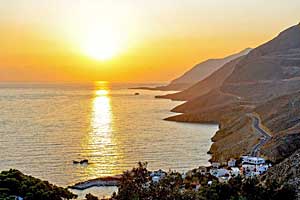|
Mizithra
Mizithra or myzithra ( ) is a Greek whey cheese or mixed milk-whey cheese from sheep or goats, or both. Barron, Rosemary (1991). ''Flavors of Greece.'' William Morrow, It is sold both as a fresh cheese, similar to Italian ''ricotta'', and as a salt-dried grating cheese, similar to Italian ''ricotta salata''. The ratio of milk to whey usually is 7 to 3. It is primarily produced on the island of Crete but is widespread throughout Greece. It is essentially the same as Anthotyros though the latter may contain some cow's milk. In Cyprus a similar cheese is known as " Anari" (Αναρή in Greek, ''Nor'' in Cypriot Turkish, ''Lor'' in Turkish). Production Mizithra is made from raw, whole ewe's or goat's milk in the simplest way possible: milk is brought to a slow boil for a few minutes and then curdled by adding rennet or whey from a previous batch (see below) or else some acidic substance such as lemon juice, vinegar or even a fresh broken fig tree sprig. As soon as curds have for ... [...More Info...] [...Related Items...] OR: [Wikipedia] [Google] [Baidu] |
Whey Cheese
Whey cheese is a dairy product made of whey, the by-product of cheesemaking. After the production of most cheeses, about 50% of milk solids remain in the whey, including most of the lactose and lactalbumin. The production of whey cheese allows cheesemakers to use the remaining whey, instead of discarding it as a waste product. There are two fundamentally different products made of whey and called whey cheese: * Albumin cheese, made by coagulating the albumin in the whey with heat and possibly acid: ricotta, mizithra, and so on. * Norwegian brown cheeses, made by boiling down the whey to concentrate the sugar, and consisting primarily of caramelized milk sugar: mysost and the like. Since these are not primarily made of coagulated milk proteins, they are technically not cheese. Cheese and whey cheese are distinct categories in the Codex Alimentarius. In the appellation system of the European Union, protected whey cheeses are included in class 1.4 for other products of animal or ... [...More Info...] [...Related Items...] OR: [Wikipedia] [Google] [Baidu] |
Fresh Cheese
There are many different types of cheese. Cheeses can be grouped or classified according to criteria such as length of fermentation, texture, methods of production, fat content, animal milk, and country or region of origin. The method most commonly and traditionally used is based on moisture content, which is then further narrowed down by fat content and curing or ripening methods. The criteria may either be used singly or in combination, with no single method being universally used. The combination of types produces around 51 different varieties recognized by the International Dairy Federation, over 400 identified by Walter and Hargrove, over 500 by Burkhalter, and over 1,000 by Sandine and Elliker. Some attempts have been made to rationalise the classification of cheese; a scheme was proposed by Pieter Walstra that uses the primary and secondary starter combined with moisture content, and Walter and Hargrove suggested classifying by production methods. This last scheme results ... [...More Info...] [...Related Items...] OR: [Wikipedia] [Google] [Baidu] |
Anari (cheese)
Anari ( gr, αναρή, tr, nor) is a fresh mild whey cheese produced in Cyprus. Although much less known than other Cypriot cheeses (e.g. halloumi), it gained popularity following publicity. One of the main industrial producers on the island won a silver medal award for anari in the 2005 World Cheese Awards in the UK. It has since become available in UK national supermarkets. Production The whey used is usually a by-product in the production process of other harder cheeses, commonly that of halloumi or kefalotyri cheese. The whey is gradually heated to in a large cooking bowl. A small amount of goat or sheep milk (5–10%) can be added at this temperature to improve the end product quality. The temperature is then increased to boiling point, whilst mixing. At small crumbly curds of anari start forming and are skimmed off the surface using a slotted spoon or a colander. They are placed in a container that allows further drainage and then cut into cubes of roughly 10 ... [...More Info...] [...Related Items...] OR: [Wikipedia] [Google] [Baidu] |
Sfakia
Sfakiá ( el, Σφακιά) is a mountainous area in the southwestern part of the island of Crete, in the Chania regional unit. It is considered to be one of the few places in Greece that have never been fully occupied by foreign powers. With a 2011 census population of 1,889 inhabitants living on a land area of , Sfakia is one of the largest and least densely populated municipalities on the island of Crete. The etymology of its name is disputed. According to the prevailing theory, it relates to its rugged terrain, deriving from the ancient Greek word ''σφαξ'', meaning land chasm or gorge. Description The road from Chania to Sfakiá crosses the island from north to south, through the village of Vryses. From this village the route crosses the White Mountains ( Lefká Óri) to Hóra Sfakíon () by the Libyan Sea. Halfway from Vrisses to Hóra Sfakíon is the fertile plateau of Askifou, surrounded by high mountain peaks. From here to Hóra Sfakíon the road is particula ... [...More Info...] [...Related Items...] OR: [Wikipedia] [Google] [Baidu] |
Crete
Crete ( el, Κρήτη, translit=, Modern: , Ancient: ) is the largest and most populous of the Greek islands, the 88th largest island in the world and the fifth largest island in the Mediterranean Sea, after Sicily, Sardinia, Cyprus, and Corsica. Crete rests about south of the Greek mainland, and about southwest of Anatolia. Crete has an area of and a coastline of 1,046 km (650 mi). It bounds the southern border of the Aegean Sea, with the Sea of Crete (or North Cretan Sea) to the north and the Libyan Sea (or South Cretan Sea) to the south. Crete and a number of islands and islets that surround it constitute the Region of Crete ( el, Περιφέρεια Κρήτης, links=no), which is the southernmost of the 13 top-level administrative units of Greece, and the fifth most populous of Greece's regions. Its capital and largest city is Heraklion, on the north shore of the island. , the region had a population of 636,504. The Dodecanese are located ... [...More Info...] [...Related Items...] OR: [Wikipedia] [Google] [Baidu] |
Homemade Mizithra
Homemade may refer to: * Handicraft, things that are made by hand *''Homemade'', '' T4'' TV series 2006 *'' HomeMADE'', Australian reality TV series 2009 *'' Homemade TV'', a Canadian children's television series 1976 to 1977 * ''Homemade'' (album), by The Osmonds 1971 *''Homemade'', album by Cephas & Wiggins 1999 * ''Home Made'' (1927 film), an American silent comedy film * ''Home Made'' (2017 film), an Israeli short film * ''Homemade'' (TV series), an Italian-Chilean anthology series * "Homemade" (song), a 2019 song by Jake Owen See also * Homemade leverage, use of personal borrowing of investors to change the amount of financial leverage of a firm {{disambiguation ... [...More Info...] [...Related Items...] OR: [Wikipedia] [Google] [Baidu] |
Vinegar
Vinegar is an aqueous solution of acetic acid and trace compounds that may include flavorings. Vinegar typically contains 5–8% acetic acid by volume. Usually, the acetic acid is produced by a double fermentation, converting simple sugars to ethanol using yeast, and ethanol to acetic acid by acetic acid bacteria. Many types of vinegar are available, depending on source materials. It is now mainly used in the culinary arts as a flavorful, acidic cooking ingredient, or in pickling. Various types are used as condiments or garnishes, including balsamic vinegar and malt vinegar. As the most easily manufactured mild acid, it has a wide variety of industrial and domestic uses, including use as a household cleaner. Etymology The word "vinegar" arrived in Middle English from Old French (''vyn egre''; sour wine), which in turn derives from Latin: ''vinum'' (wine) + ''acer'' (sour). Chemistry The conversion of ethanol (CH3CH2OH) and oxygen (O2) to acetic acid (CH3COOH) takes ... [...More Info...] [...Related Items...] OR: [Wikipedia] [Google] [Baidu] |
Cheesecloth
Cheesecloth is a loose-woven gauze-like carded cotton cloth used primarily in cheesemaking and cooking. Grades Cheesecloth is available in at least seven different grades, from open to extra-fine weave. Grades are distinguished by the number of threads per inch in each direction. Uses Food preparation The primary use of cheesecloth is in some styles of cheesemaking, where it is used to remove whey from cheese curds, and to help hold the curds together as the cheese is formed. Cheesecloth is also used in straining stocks and custards, bundling herbs, making tofu and ghee, and thickening yogurt. Queso blanco and queso fresco are Spanish and Mexican cheeses that are made from whole milk using cheesecloth. Quark is a type of German unsalted cheese that is sometimes formed with cheesecloth. Paneer is a kind of Indian fresh cheese that is commonly made with cheesecloth. Fruitcake is wrapped in rum-infused cheesecloth during the process of "feeding" the fruitcake as it ripen ... [...More Info...] [...Related Items...] OR: [Wikipedia] [Google] [Baidu] |
Cone (geometry)
A cone is a three-dimensional geometric shape that tapers smoothly from a flat base (frequently, though not necessarily, circular) to a point called the apex or vertex. A cone is formed by a set of line segments, half-lines, or lines connecting a common point, the apex, to all of the points on a base that is in a plane that does not contain the apex. Depending on the author, the base may be restricted to be a circle, any one-dimensional quadratic form in the plane, any closed one-dimensional figure, or any of the above plus all the enclosed points. If the enclosed points are included in the base, the cone is a solid object; otherwise it is a two-dimensional object in three-dimensional space. In the case of a solid object, the boundary formed by these lines or partial lines is called the ''lateral surface''; if the lateral surface is unbounded, it is a conical surface. In the case of line segments, the cone does not extend beyond the base, while in the case of hal ... [...More Info...] [...Related Items...] OR: [Wikipedia] [Google] [Baidu] |
Honey
Honey is a sweet and viscous substance made by several bees, the best-known of which are honey bees. Honey is made and stored to nourish bee colonies. Bees produce honey by gathering and then refining the sugary secretions of plants (primarily floral nectar) or the secretions of other insects, like the honeydew of aphids. This refinement takes place both within individual bees, through regurgitation and enzymatic activity, as well as during storage in the hive, through water evaporation that concentrates the honey's sugars until it is thick and viscous. Honey bees stockpile honey in the hive. Within the hive is a structure made from wax called honeycomb. The honeycomb is made up of hundreds or thousands of hexagonal cells, into which the bees regurgitate honey for storage. Other honey-producing species of bee store the substance in different structures, such as the pots made of wax and resin used by the stingless bee. Honey for human consumption is collected from ... [...More Info...] [...Related Items...] OR: [Wikipedia] [Google] [Baidu] |
Whey
Whey is the liquid remaining after milk has been curdled and strained. It is a byproduct of the manufacturing of cheese or casein and has several commercial uses. Sweet whey is a byproduct resulting from the manufacture of rennet types of hard cheese, like cheddar or Swiss cheese. Acid whey (also known as sour whey) is a byproduct brought out during the making of acid types of dairy products, such as strained yogurt. Whey proteins consist of α-lactalbumin, β-lactoglobulin, serum albumin, immunoglobulins, and proteose peptones. Composition Whey protein is the collection of globular proteins isolated from whey. The protein in cow's milk is 20% whey protein and 80% casein protein, whereas the protein in human milk is 60% whey and 40% casein. The protein fraction in whey constitutes approximately 10% of the total dry solids in whey. This protein is typically a mixture of beta-lactoglobulin (~48-58%), alpha-lactalbumin (~13-19%), bovine serum albumin (~6%)(see also ser ... [...More Info...] [...Related Items...] OR: [Wikipedia] [Google] [Baidu] |







.jpg)


